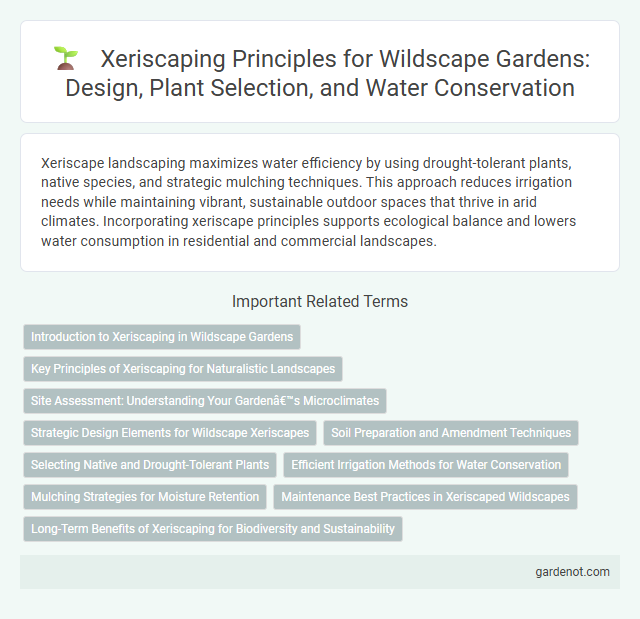Xeriscape landscaping maximizes water efficiency by using drought-tolerant plants, native species, and strategic mulching techniques. This approach reduces irrigation needs while maintaining vibrant, sustainable outdoor spaces that thrive in arid climates. Incorporating xeriscape principles supports ecological balance and lowers water consumption in residential and commercial landscapes.
Introduction to Xeriscaping in Wildscape Gardens
Xeriscaping in Wildscape Gardens employs drought-tolerant plants native to arid environments, reducing the need for supplemental irrigation and promoting sustainable landscaping practices. This landscaping technique features succulents, ornamental grasses, and native shrubs that thrive in low-water conditions, enhancing biodiversity and conserving water resources. Wildscape Gardens integrates xeriscaping principles to create visually appealing, eco-friendly spaces that minimize water use while supporting local ecosystems.
Key Principles of Xeriscaping for Naturalistic Landscapes
Xeriscaping emphasizes water-efficient landscape design by incorporating drought-tolerant native plants, efficient irrigation methods, and soil enhancement techniques to minimize water use. Key principles include thoughtful plant selection based on climate adaptability, grouping plants with similar water needs, and using mulch to retain soil moisture and reduce evaporation. Integrating these strategies creates sustainable, naturalistic landscapes that conserve water while maintaining aesthetic appeal.
Site Assessment: Understanding Your Garden’s Microclimates
Site assessment is crucial for optimizing xeriscape design by evaluating the garden's microclimates, including variations in sunlight, soil type, and moisture levels. Identifying sun exposure patterns and wind flow helps select drought-tolerant plants suited to specific zones, enhancing water efficiency. Detailed analysis of soil drainage and texture informs irrigation strategies, reducing water waste and promoting sustainable landscaping.
Strategic Design Elements for Wildscape Xeriscapes
Strategic design elements for wildscape xeriscapes include native plant selection, which promotes biodiversity and resilience in arid environments. Incorporating layered vegetation structures creates microhabitats supporting local wildlife while optimizing water use efficiency. Utilizing permeable surfaces and natural rock formations aids in efficient stormwater management, enhancing soil moisture retention and reducing irrigation needs.
Soil Preparation and Amendment Techniques
Effective xeriscape soil preparation involves testing soil pH and texture to determine nutrient deficiencies and drainage capabilities. Incorporating organic matter such as compost or well-aged mulch enhances water retention and improves soil structure, crucial for drought-tolerant plants. Amending soil with gypsum or sand can increase permeability, preventing water runoff and promoting deep root growth essential in arid landscapes.
Selecting Native and Drought-Tolerant Plants
Selecting native and drought-tolerant plants for xeriscape landscapes enhances water efficiency by reducing irrigation needs. Native species such as lavender, sage, and yucca thrive in arid conditions while supporting local ecosystems. Incorporating deep-rooted, drought-resilient plants improves soil health and minimizes maintenance in sustainable wildscapes.
Efficient Irrigation Methods for Water Conservation
Xeriscape landscaping employs efficient irrigation methods such as drip irrigation and sub-surface watering systems that significantly reduce water waste by delivering moisture directly to plant roots. Utilizing smart irrigation controllers equipped with weather sensors optimizes water use by adjusting schedules based on local climate conditions and soil moisture levels. These techniques enhance water conservation efforts and promote sustainable landscape maintenance in arid environments.
Mulching Strategies for Moisture Retention
Mulching strategies in xeriscape design significantly enhance moisture retention by reducing evaporation and insulating soil. Organic mulches such as wood chips, bark, and compost improve soil structure while conserving water, making them ideal for arid landscapes. Proper mulch application depth, typically 2 to 4 inches, ensures optimal hydration and supports drought-tolerant vegetation in wildscape environments.
Maintenance Best Practices in Xeriscaped Wildscapes
Xeriscaped wildscapes require minimal water use and thrive on drought-tolerant native plants, reducing irrigation frequency to conserve resources. Pruning should be done sparingly to maintain natural growth patterns, while mulch layers help retain soil moisture and suppress weeds effectively. Regularly inspecting plants for pests and diseases ensures a healthy ecosystem with sustainable maintenance efforts.
Long-Term Benefits of Xeriscaping for Biodiversity and Sustainability
Xeriscaping enhances biodiversity by supporting native plants and creating habitats for local wildlife, reducing dependency on water-intensive species. This sustainable landscaping method conserves water resources, lowers maintenance costs, and minimizes chemical inputs, promoting ecosystem health. Over time, xeriscaping contributes to resilient urban environments by mitigating soil erosion and improving air quality.
Xeriscape Infographic

 gardenot.com
gardenot.com